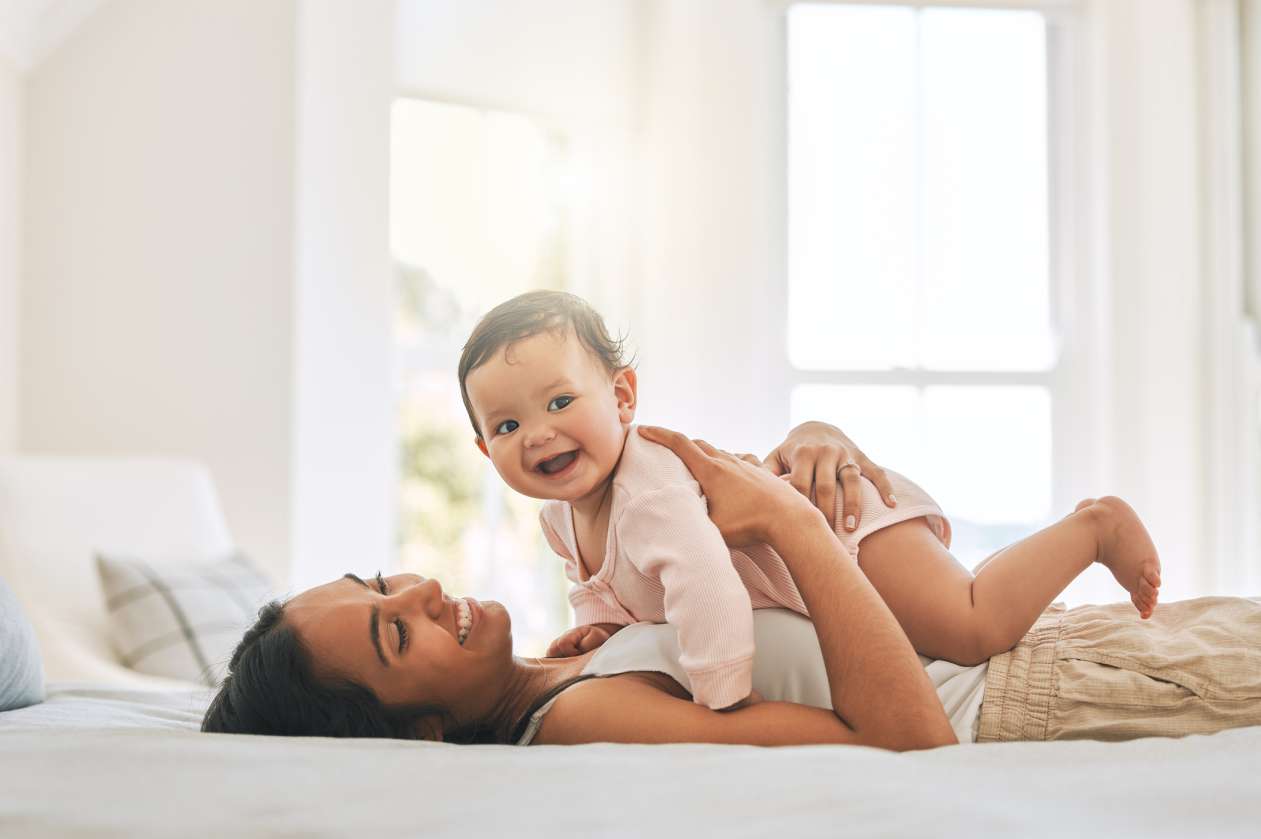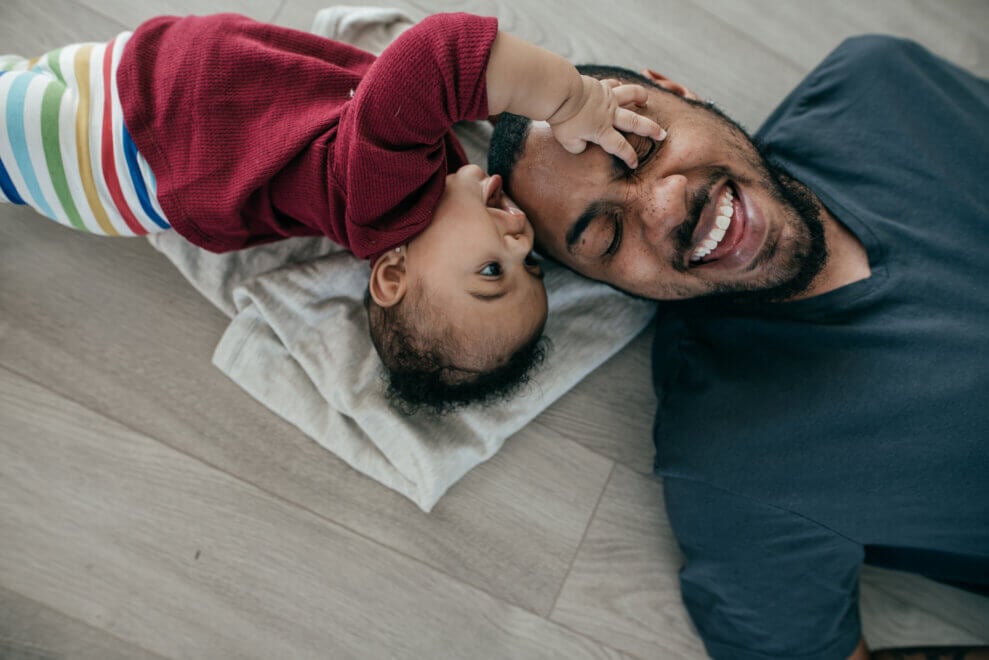
Indoor activities for infants
I love babies. If I didn’t have to go through the challenges of pregnancy I would have had a dozen babies. I kid you not! Instead I settled on five, which keeps me very busy. My youngest little one is currently two months old and I love nuzzling his fuzzy little head every opportunity I get. Infancy is such a short and fleeting phase. Those wise grannies know what they’re talking about when they say that babies don’t keep.
During the first 12 months of life, babies grow at an incredible rate. By one year of age most babies have tripled their birth weight and increased their height by 50%! Babies also experience amazing physical, emotional, social, and language milestones from birth to one year and there are many great indoor activities we can do with our infants to support their development.
In this article, I’ll break down infancy into four stages (0 to 3 months, 4 to 6 months, 7 to 9 months and 10 to 12 months), go over major milestones for each stage, and offer some fun indoor activities you can do with your baby to help her meet various development milestones.
Indoor activities for infants ages 0 to 12 months
Infancy is the first stage of your child’s life and begins the moment he’s born to 12 months of age. If your baby was born premature, more than three weeks early, you may have to calculate her “corrected age” to get a better sense of what milestones she should be meeting. One quick note: it’s important to remember that each infant develops at his or her own rate. However, if you’re concerned about your baby meeting developmental milestones please visit your family physician or public health nurse.
Indoor activities for all infant stages
Let’s start with a few indoor activities that are perfect for all stages of infancy.
Read books together
Reading to your infant from the moment she’s born is a powerful way to help her with language development. While your baby might not be able to see pictures clearly or understand words when she’s newborn, listening to sounds patterns helps develop literacy from the get-go. I like to make reading a part of our daily routine early on. I usually read my baby a book before naptime or bedtime, which helps him develop a solid sleep time routine. The public library is a great place to explore the world of children’s literature.
Listen to music
Babies love music. Whether you’re singing a lullaby or listening to tunes in the car, music helps your infant’s brain develop. As your baby gets a little older, start incorporating songs with gestures like “The Itsy Bitsy Spider” or “Five Little Monkeys.”
For more ideas on how to help your infant develop their literacy skills, the Canadian Paediatric Society has a great resource called Read, speak, sing to your baby: How parents can promote literacy from birth.

Indoor activities for 0- to 3-month-old infants
From newborn to three months, infants are steadily developing head control, eye coordination, social smiling, and hand, arm, and leg movements. To help your young infant work on these skills, try one of these fun and simple indoor activities:
Tummy time training
Tummy time training is very important for helping your infant develop head and neck control. With daily practice, your baby will go from barely lifting his head to doing a mini push-up around three months. Tummy time also strengthens your baby’s arms, legs, back, hips, and hands. Talk about a whole body workout! For tummy time, place your infant tummy down on a blanket on the floor. Start with short periods of time, about three to five minutes, and work up to an hour of tummy time a day by three months of age. You can also try tummy time by laying your baby on your own tummy, across your knees, or on an exercise ball. For more tummy time tips and ideas, read 7 steps to get your infant ready for tummy time.
Pedalling away
This activity strengthens your baby’s abdominal and leg muscles, and helps with knee, joint, and ankle mobility. To practice pedalling, lay your infant on her back and pedal her legs as if she’s riding a bike. You can even sing “The Wheels on the Bus” or “The Wheel on the Bike” to your baby while you pedal her legs. An added bonus to this activity is that it calms a fussy baby and relieves abdominal gas.
Kicks for babies
Free those feet for kicking practice! Lay your baby on his back or tummy and place a textured blanket or crinkly tissue wrapping paper at his feet to encourage kicking. I like to do this activity while my baby is barefoot to stimulate his sense of touch. Try experimenting with other items like a cookie pan, bubble wrap, or foot rattles. Getting those little legs kicking builds strength and helps to develop movement awareness for rolling over.
Do you see what I see?
When babies are born, their vision is blurry and they can only see objects about 20 to 25 cm (8 to 20 inches) away. Despite their poor vision, infants at this age love to look at faces, high-contrast images, lights, and moving objects. When your baby is awake and alert, go for a slow walk around your home and pay attention to what grabs his attention. You can also make a “photo album” for your baby by gluing a few pictures of her family members onto a piece of cardboard for her to look at during tummy time.
Baby sit-ups
Sitting independently won’t happen for a while but baby sit-ups will help strengthen your infant’s abdominal muscles. A baby sit-up is a fully assisted sit-up. Place your baby on the floor and use your hand to support her shoulders, neck, and head. Gently bring her into a sitting position and then lay back down again. That’s it! This is another activity that can help release built-up gas in a fussy baby.

4 to 6 months old
From four to six months, infants are becoming more aware of their hands, feet, arms, and legs. At this age, babies are starting to reach out for objects, play with their feet, sit with support, scoot, and roll over.
Roll over baby
Around four months, infants can roll from tummy to his back, and by five to six months they can roll from back to tummy. To help your baby practice this skill, place him on a blanket and gently lift the edge of the blanket to encourage your baby to roll over. This activity will help your baby get used to the sensation of rolling and most babies find it quite fun. You can also encourage rolling by propping your baby on her side with a rolled up towel or placing toys just out of her reach.
Let’s play ball!
Balls of different sizes and texture are perfect for infants to play with. Flexible balls with large holes are easier for younger babies to grasp and manipulate. One fun activity is to prop your baby into a sitting position between your legs and show him how to roll the ball on the ground. Another idea is to dust off that large exercise ball and let your baby push it around.
Peek-a-boo
Around four months, a baby learns about object permanence and that makes playing peek-a-boo so much fun! Object permanence is the concept that even if you can’t see, touch, smell, or touch something, it’s still there. To play peek-a-boo with your baby, hide your face behind a blanket or your hands then dramatically take them away and say “Peek-a-boo!” Some babies might be surprised at first but it quickly becomes a fun game that elicits smiles and maybe even those first giggles.
Baby in the middle
Infants don’t start crawling until closer to nine months, but around four to six months they start to push, roll, and scoot around. To encourage your baby to explore her surroundings and strengthen her crawling muscles, play baby in the middle! Lay your baby on the floor, tummy down, and place a variety of baby safe objects or toys around her. Encourage her to reach, roll, and scoot to grasp the objects around her and celebrate her wins.
Stand up, buttercup
Babies are born with a “walking” reflex. If their feet touch a surface, they take a few steps. This reflex fades after two months but is replaced with the ability to “stand” around three to four months. To encourage your baby to strengthen their standing muscles, hold them in a standing posting on your lap or a firm surface for a few seconds. By six months, your baby should be able to hold their own weight with only a little help from you.

7 to 9 months old
From seven to nine months, infants are becoming much more mobile and strong. At this age, babies start to sit without support, crawl around, stand with assistance, cruise along furniture, and pick up, pass, and throw objects.
Little floor explorer
Most babies learn to crawl between seven to 10 months of age and use their newfound skill to explore the world around them. You can make their indoor surroundings a little more adventurous by placing interesting objects and “challenges” for them to discover. Stack pillows on the ground to make a “mountain” to crawl over or lay a “river” of blankets to wade across. Leave random times like balled-up socks, a plastic cup, wooden blocks, etc.
A round of applause
Seeing a baby clap is the cutest thing! This milestone usually starts developing around seven months and by nine months most babies can clap. You can encourage your baby to clap by showing them how it’s done, clapping along to music or playing games like Patty Cake or giving high-fives. To keep your baby clapping, check out these 17 song and game ideas.
Baby tug-of-war
Babies have little but mighty hands. Gripping is an important motor skill that helps them learn how to pull themselves up and hold objects like food, toys, and eventually a crayon. To play tug-a-war, get your baby to hold one tea towel or small blanket and you hold the other. Gently tug back and forth and see if your baby can “win” by pulling the towel out of your hands.
Bouncing baby
Around seven months, babies will bounce in place when supported and they love it! Bouncing in place helps your baby develop their leg muscles, which will help them get stand on their own and eventually walk. Hold your baby on different surfaces inside your home (a bed, the floor, a fuzzy rug, an exercise ball) and encourage them to bounce up and down. I like to say “bounce bounce” while my baby bounces to build their movement vocabulary.
Mini chef
Babies start eating solids around the age of six months. From seven to nine months, Baby likes to explore new flavours and textures and play with pots and pans! Set up baby-safe cooking and baking items on the floor for your baby to play with (metal pots, lids, and wooden spoons), try out some pureed food finger painting, and let your baby touch and hold whole fruits and veggies (an orange, apple, pineapple, tomato, etc.).

10 to 12 months old
From 10 to 12 months, infants are on the go. At this age, babies can usually crawl around, stand without assistance, and cruise along furniture. They might even start taking their first steps!
Baby obstacle course
Get your baby practicing her newfound gross motor skills (crawling, cruising, and standing) with a baby obstacle course. Make a tunnel with a play mat or large box to crawl through, use large couch cushions to crawl over, try an ottoman to encourage pulling up and cruising, and incorporate balls to roll and toss.
Big paper art
During the last three months of infancy, babies are learning how to use a pincer grasp so this is a great age for introducing big paper art. To make big paper art, tape a large piece of paper on the ground and give your baby a chunky crayon to draw with. It’s a good idea to keep a close eye on your baby for this activity since she’ll probably try to chew on the crayon.
What’s inside?
Fill a shoe box or small basket with a variety of baby-safe objects and let your baby empty and refill the box. This simple indoor activity is great for developing hand-eye coordination and fine motor skills. Another fun activity is putting scarves into an empty tissue box and letting your baby pull them out, which helps develop their pincer grasp.
Toss it!
Around 12 months of age, babies start to throw things. It might start with your baby tossing food on the floor or a book off the bookshelf. While food and books aren’t the ideal things to be throwing around, throwing is an important skill for your baby to practice. A soft small ball is a great object to toss and throw. If your baby isn’t throwing things yet, start by rolling the ball on the ground. Then try bouncing the ball on the ground. Next encourage your baby to toss the ball into a basket. Throwing the ball underhand will follow but it might take a little longer to get there—closer to 18 months.
Copycat
Babies love to copy their parents and caregivers. Mimicking is an important part of how babies learn and a great way to encourage babies to practice different skills. Play copycat with your baby by modelling different actions: clap, blow raspberries, flap your arms, wave, etc. When your baby copycats you make a big deal out of it! This is a great infant activity for developing their motor and social skills.

Wrapping it up
I hope you and your baby have fun trying these activities at home. Did I miss your favourite indoor activity for infants? Feel free to share it below!


